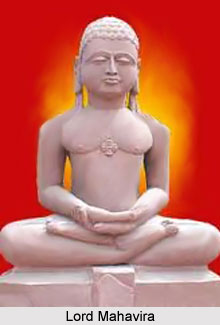 Jainism is the religion followed by the Jains. The Jain community, with its distinctive cultural heritage has drawn adherents from almost all the different races, castes and classes inhabiting the different parts of this ancient country. Jainism is a prominent and well-recognized religious and cultural system belonging to India. It is the representative of that antique Sramana current of Indian culture. It was non-vedic and probably non-Aryans and even pre-Aryans.
Jainism is the religion followed by the Jains. The Jain community, with its distinctive cultural heritage has drawn adherents from almost all the different races, castes and classes inhabiting the different parts of this ancient country. Jainism is a prominent and well-recognized religious and cultural system belonging to India. It is the representative of that antique Sramana current of Indian culture. It was non-vedic and probably non-Aryans and even pre-Aryans.
At present most of the community members comprises more than two dozen subdivisions of the Vaishya caste. Many of them also belong to of the Brahmin, Kshatriya and Sudra castes and also of several unidentified caste- groups.
Education and literacy rate is very high. The followers of Jainism are famous for their philanthropy, charitable institutions and works of public welfare. In the food habit, the Jains are prefect vegetarians, rather lacto-vegetarians, don`t consume meat, fish or egg, nor drink spirituous liquors. They follow the philosophy of non-violence as best and avoid hurting or killing any life form. Jain monks are expected to walk gently, so as not to crush the living atoms
The Jains have extended their activities beyond religious literature. They have several accomplishments in the secular science to their credit, in doctrine, grammar, lexicography, poetics, mathematics, astronomy and astrology, and even in the science of politics.
The Jains also occupy a prominent place in the history of Indian literature and Indian thoughts. The Jains have also provided services in Southern India, in developing the Dravidian languages, Tamil language and Telugu language and particularly the Kanarese literary language. They have also contributed a considerable amount in Gujarati, Hindi, and Marwari. It is a total system with all the necessary branches, such as dogma or ontology, metaphysics, philosophy, epistemology, mythology, morals, rite, and the rest. It is also into several denominations and sub-sects. It has its own deities, gurus and Holy Scriptures, its own temples, places of worship and pilgrimage. It also comprises of its own festivals and fairs. Besides devotees, it possesses well-organized ascetic orders, comprising both male and female monks.
Denominations of Jainism
The two principal denominations of Jainism are the Digambar Sect (sky-clad) and the Shvetambar (white-clad). The Digambars go about naked and the followers of Shvetambar wear scanty, white cloths. Each of the major denominations is further divided into at least three different sub-sects. The Digambar is divided into Terahapantha of Suddhamnaya, the Bisapantha, and the Taranapanth or Samaiya, while the Shvetambar into the Samvegi or temple-worshipper, the Sthanakavasi or Sadhumargi and the Teranpanth. The Digambar Terahapantha maintains strict devotion to the thirteen (teraha) rules of ascetic behaviour. It is more puritanical and austere, even in the temple worship.
The Samaiya or Taranapantha do insist on temple or image worship, and possesses practically no ascetic order. The Samvegis amongst the Shvetambars are temple worshipers and constitute the bulk. The Sthanakavasis, who emerged during the came 15th century AD., do not believe in temple worship. They believe in adoration of ascetic gurus. Buildings reserved for the latter group are called Sthanakas. A later derivation from the Sthanakvasi denomination is the Svethambara Terapantha. The organization is more rigid and unitary. They are subject to the dictates of only one man, the Acharya or chief pontiff.
The cultural contributions of Jainism have not been duly evaluated. Certain seals as old as perhaps five to eight thousand years that belonged to the pre-historic Indus valley civilization bear the figures of a nude yogin in a Jain kayotsarga posture. It also has a bull emblem. Even the presence of a nude male Harappan torso, certify the prevalence of the worship of Rishabh or Adinath (the First Bhagwan) of Jain custom in that remote age. Bhagvan Rishabh is alluded directly and indirectly even in a number of hymns of the Rigveda. Apart from him him, several other Tirthankars, who succeeded him, find mention in the Vedic literature, and the Brahmanical Puranas have treated Rishabh as an early avatar of the Lord Vishnu. In the philosophical literature of ancient India, Jainism finds place as a prominent non-Brahmanical system. Several records, literary references, monuments and antiquities belonging to subsequent centuries point out the major role that Jainism has played during the last two thousand and five hundred years in the life and culture of the Indian subcontinent.




















